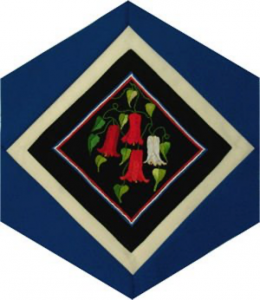Chile

The Block
Velvet, a fabric commonly used in the belts of traditional Chilean costumes, provides the dramatic backdrop for this block. Elizabeth Comas embroidered Chile’s national flower, the bellflower or copiheus, in varying tones of red and white interconnected by swirling leaves in delicate shades of green. They are framed by tightly stitched bands of thread in the national colours of red, white and blue. This tri-colour combination is often found as part of the national costume on a sash or belt. It is also used in ribbons and bunting that are commonly draped on special occasions in Chile.
Cultural Profile
Chile is a unique country that includes almost every type of climate and landscape in the world. The country measures over 4000 km in length and averages only 177 km in width, so Chileans like to say they are ‘living on a shoestring’. Spanish is the national language although English is spoken in major cities. The population is relatively homogeneous, compared to other South American countries due to the relative geographical isolation of the country as it is separated from the rest of the continent by the Andes. This isolation has also led to a distinctive Chilean culture and accent. While the Spanish influence on the culture is obvious, the indigenous contribution, especially from the Mapuche, is still very present. Waves of European immigrants over the last century have also impacted Chilean culture.
Easter Island is also a territory of Chile. This island, with its own distinctive culture is famous not only for its 1,000 carved volcanic rock statues (moai), but also for its rock art and rock engraving dating back many centuries.
The cosmopolitan culture of Chile’s cities and the popular culture of the peasants that has influenced music and dance, demonstrate the contrasts of Chilean life. Similar to the Argentinian gaucho, the Chilean huaso is a key figure in the country’s traditions. Originally a farmer and cattle herder from the central and southern regions of Chile, he and his sweetheart, the huasa or china, are central figures in parades, fiestas and folk music. Their attire are considered the traditional dress of Chile. The huaso wears a chamanto, a reversible poncho edged with ribbons and designs of flowers, plants or birds woven in the wool and silk fabric. Knee-high leather boots, spurs, the chupalla (a flat-top straw hat) and a tailored shirt complete his outfit. The dress of the china consists of a ruffled blouse and the pollera, a large one-piece skirt of Spanish origin worn over many underskirts and embellished with embroidered flowers. Though the pollera is often considered to be indigenous clothing in neighboring South America countries, in Chile it is the traditional dress of all Chilean women, regardless of their ancestry. The cueca, Chile’s traditional dance, is often the best occasion to see the traditional Chilean clothing.
The Mapuche, who represent around 9% of Chile’s overall population, have preserved their weaving traditions, first using alpaca and lama hair, then sheep wool. In the village of Rari, in the Linares province, horse hair is used. Done exclusively by the women, weaving was taught in the home and the Mapuche women continue to play a significant role in the economy through the sale of their textiles. The Mapuche were also noted for their intricately crafted silver jewelry, however, their techniques were lost over time. Fortunately, many fine examples of this past art have survived.
Chile’s contemporary literature has earned international praise through the works of novelists Isabel Allende and Luis Sepulveda, or poets Pablo Neruda and Gabriela Mistral. Traditional musical styles include the cueca music featuring acoustic guitars, accordion, the melancholic tonada, and voice.
Chileans, noted for their warmth and resilience, have a strong sense of home and family. Political awareness and involvement is also a Chilean trait that is probably a legacy of the long, dictatorial regime of Augusto Pinochet that lasted from 1973 to 1990.
Large groups of Chileans began coming to Canada in 1973 and there are now over 38,000 living mainly in Montreal, Toronto, Calgary, Edmonton and Vancouver. They have opened stores, created consulting firms and publish several Spanish-language magazines and newspapers, contributing to the Canadian culture while maintaining their own.
Sponsor: Ron Kubelka, in memoriam Miss Marie Patterson
